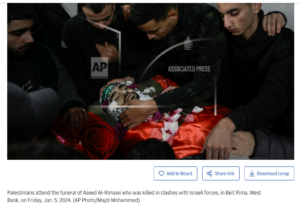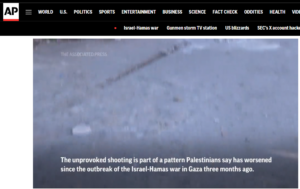The Associated Press prides itself on “expand[ing] the reach of factual reporting,” but that reach has its clear limits. Today’s 1200-word feature on the overnight Jan. 5 fatal shooting of Palestinian Osaid Rimawi once again demonstrates the boundaries of AP’s commitment to “advancing the power of facts” (“Video appears to show the Israeli army shot 3 Palestinians, killing 1, without provocation“).
About 17-year-old Osaid Rimawi, described as “a high school student studying to become a barber,” AP’s Julia Frankel reported: “Security camera video from a West Bank village shows a young man standing in a central square when he is suddenly shot and drops to the ground.”
Frankel recounted that, according to a witness, Rimawi had gathered cardboard boxes and scraps of paper and was preparing to light them to keep warm when Israeli troops shot him dead, unprovoked. He slipped something into his pocket right before he was shot dead. His brother later found Osaid had been carrying a lighter, 20 shekels, and a pack of cigarettes in his pocket when he died. His brothers Mohammed and Nader, who were also wounded in the shooting, normally work in a factory, packaging prepared salads. They will not be able to work until they can walk again.
Indeed, Frankel provides an abundance of details and facts in her 1200 investigative piece.
But it’s more what Frankel neglects to report which exposes the AP’s curbed commitment to factual reporting. At no point does the long, in-depth investigative piece share with readers that the aspiring young barber already had some beyond-his-years experience under his belt: he was a member of Hamas, a designated terror organization which just three months ago carried out one of the worst massacres in recent history with thousands of barbaric atrocities targeting civilians, including women, children, people with special needs, and the elderly.
@AP describes 17-year-old fatality Osaid Rimawi as “a high school student studying to become a barber.” You know what @FrankelJulia doesn’t say about Rimawi in her 1200+ word piece? He belonged to a designated terror org. Here he is in @AP photo w/Hamas headband https://t.co/HAPWCYobxJ pic.twitter.com/zNhCfacriT
— Tamar Sternthal (@TamarSternthal) January 10, 2024
 While Frankel seemingly left no stone unturned analyzing both video of the fatal incident obtained from a nearby smoke shop along with social media postings about the deadly shooting, she completely ignored AP’s own photographs from Osaid Rimawi’s funeral. Those photographs show Rimawi’s body decked out with a Hamas headband adorning his head, testifying to his affiliation in the designated terror organization.
While Frankel seemingly left no stone unturned analyzing both video of the fatal incident obtained from a nearby smoke shop along with social media postings about the deadly shooting, she completely ignored AP’s own photographs from Osaid Rimawi’s funeral. Those photographs show Rimawi’s body decked out with a Hamas headband adorning his head, testifying to his affiliation in the designated terror organization.
Notably, AP’s devotion to expanding the reach of factual reporting stops at the factual description of Hamas as a designated terror organization. Its style guide encourages its reporters to refrain from calling the Oct. 7 massacre terrorism, and from referring to Hamas as terrorists, directives which have prompted a bipartisan congressional rebuke.
But in this story, Frankel doesn’t even share that Rimawi was a Hamas “militant,” as AP urges its writers to whitewash. She “cleaned up” the Hamas terrorist, presenting him as nothing more than an uninvolved high school student with dreams of being a barber. His affiliation with the terror organization is highly relevant to any factual reporting of his death given that it casts doubt on Frankel’s carefully constructed narrative of Rimawi’s innocence in the allegedly unprovoked shooting.
 Indeed, in the accompanying video, AP goes all the way with its “unprovoked” allegation, stating the unproven scenario as fact without any kind of qualification (1:59 into the video):
Indeed, in the accompanying video, AP goes all the way with its “unprovoked” allegation, stating the unproven scenario as fact without any kind of qualification (1:59 into the video):
The unprovoked shooting is part of a pattern Palestinians say has worsened since the outbreak of the Israel-Hamas war in Gaza three months ago.
Thus, instead of expanding the reach of factual reporting, AP expands the definition of factual reporting to include unproven suppositions.
Indeed, the “unprovoked shooting” was not the only time today in which AP repackaged unfounded assumptions as fact. In a separate Associated Press article today, veteran reporter Edith M. Lederer alleges (“US defends its veto of call for Gaza cease-fire while Palestinians and others demand fighting stop“):
As a sign of the growing division among Jews over the war, three dozen rabbis from the group Rabbis 4 Ceasefire came to the U.N. as tourists to protest Israel’s offensive in Gaza.
American Jews are overwhelmingly united in support of Israel continuing its ground operation in Gaza and also approve of President Joe Biden’s response to the war, according to a new survey commissioned by the Israel on Campus Coalition.
The poll, conducted by Schoen Cooperman Research (SCR), found that 81% of American Jews support Israel continuing its military operation to “recover all Israeli hostages and remove Hamas from power.” Only 12% of respondents said they preferred “an immediate ceasefire to save Palestinian lives, even if that means “Israeli hostages aren’t recovered and Hamas remains in power.”
Unless there are two polls taken at different times to demonstrate the alleged “growing division among Jews over the war,” factual reporting requires a correction. Moreover, absent such substantiation, factual reporting dictates noting that the radical fringe Rabbis 4 Ceasefire represents no one beyond their miniscule membership.
